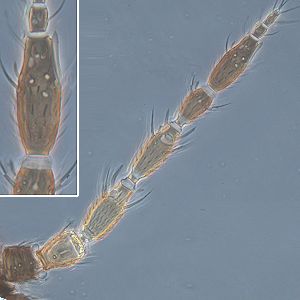Figures
Fig. 1: Antenna (inset: sense cone of antennal
segment VI)
Fig. 2: Head dorsal with ocellar triangle
Fig. 3: Pronotum
Fig. 4: Meso- and metanotum
Fig. 5: Forewing
Fig. 6: Fore tarsus
Fig. 7: Tergites II and III
Fig. 8: Tergites VIII and IX
Taxonomic Information
Species:
Odontothrips loti (Haliday, 1852)
Synonyms:
Taeniothrips distalis Karny, 1971
Odontothrips brevis Bagnall, 1964
Odontothrips brevipes Bagnall, 1934
Odontothrips quadrimanus Bagnall, 1934
Odontothrips thoracicus Bagnall, 1934
Odontothrips anthyllidis Bagnall, 1928
Odontothrips fasciata Priesner, 1926
Odontothrips uzeli Bagnall, 1919
Odontothrips adustus Priesner, 1914
Euthrips ulicis californicus Moulton, 1907
Physopus ulicis Uzel, 1895
Thrips loti Haliday, 1852
Common name:
Birdsfoot trefoil thrips
Present taxonomic position:
Family: Thripidae Stephens, 1829
Subfamily:
Thripinae (Stephens) Karny, 1921
Genus:
Odontothrips Amyot & Serville, 1843
Species Recognition
General information about the genus Odontothrips:There are 30 species in the genus Odontothrips most breed in legume flowers. This genus is thought to be closely related to the genus Megalurothrips and shares similar taxonomic characteristics. However, Odontothrips can be separated from the later genus by having one or two claws on the fore tibia.
Typical character states of Odontothrips loti:
Body color
Mainly brown
Antennae
Number of antennal segments: 8
Segment IV - forked sensorium: scarcely extending beyond base of segment V
Segments II and III shape: more or less symmetric
Segments III & IV sensoria: emergent and forked
Base of sensorium on antennal segment VI: more than 4 times as wide as base of nearest seta
Terminal antennal segments: rarely elongate
Head:
Distance between bases of ocellar setae III: greater than width of first ocellus
Head shape between compound eyes: not prolonged
Major postocular setae: less than half as long as ocellar setae III
Ocellar setae III on head: arising on anterior margin of, or in front of, ocellar triangle
Postocular setae I: present
Surface of head, pronotum and fore legs: without strong reticulate sculpture
Ocellar setae I in front of anterior ocellus: present
Prothorax
Number of pairs of elongate pronotal setae: 0-3
Number of pairs of elongate posteroangular pronotal setae: 2
Pronotum shape: rectangular
Number of pairs of pronotum posteromarginal minor setae: 4-5
Number of pairs of pronotum anteromarginal minor setae: 1
Mesothorax
Mesothoracic endofurca: with median spinula
Metathorax
Metanotal median setae length: longer than lateral metanotal setae
Metanotal median setae position: arising at anterior margin
Metanotum: without campaniform sensilla
Metanotum major sclerite: with two major sclerites, metascutum and metascutellum
Metanotum median area: with no equiangular reticulation
Metanotum sculpture: without dominant sculptured triangle medially
Metathoracic endofurca: transverse, sometimes with simple median spinula
Wings
Wings: present and more than half as long as abdomen
First vein of forewing: distinct from costal vein
Forewing anterior margin: with setae and cilia but cilia longer than setae
Forewing color: uniformly dark or shaded, but with base (or sub-base) pale
Forewing costal fringe of cilia: arising at anterior margin of wing
Forewing costal setae at middle of wing: longer than median width of wing
Forewing first vein setal row: complete, with setae closely and uniformly spaced
Forewing posterior margin cilia: undulated near apex
Forewing second vein setal row: complete, with setae closely and uniformly spaced
Forewing surface: not reticulate
Forewings: with veins, setae and microtrichia
Legs
Fore tarsus inner apex: with small pointed tooth
Fore tibial apex: with small curved claw ventrolaterally
Mid and hind tarsi: with two segments
Abdomen:
Abdominal pleurotergites: not covered in microtrichia
Abdominal segment X: never tubular, longitudinally incomplete ventrally in both sexes
Abdominal sternite III of female: without glandular areas
Abdominal sternite VII: with marginal setae but no discal setae
Abdominal sternite VII median marginal setae: arising in front of margin
Abdominal sternites IV , V and VI: with marginal setae but no discal setae
Number of lateral marginal setae on abdominal tergite II: 4
Abdominal tergites: without curved wing-retaining setae
Abdominal tergites IV & V median setal pair: much shorter than distance between their bases
Abdominal tergites V-VII: without paired ctenidia, sometimes with irregular microtrichia
Setae on abdominal tergite X: slender
Surface of lateral thirds of abdominal tergites: without regular rows of fine microtrichia
Tergite VIII posteromarginal comb of microtrichia: present laterally, incomplete medially
Tergite VIII posteromarginal microtrichia: long, slender and irregular
Biology
Life history:
As with other thrips species the life cycle from egg to adult is dependent on temperature. The full cycle can take about 15 days (Lewis, 1973) to over a month and adults may live for more than one month producing several generations in one year depending on seasonal weather. With greenhouse temperatures the developmental time from egg to adult can decrease to about one week.
Host plants:
Legumes
Vector capacity:
None identified
Current known distribution:
Asia, Europe, North America
Additional notes:
In California, Odontothrips loti is commonly found in lupine flowers in the spring.
Bibliography
Lewis, T (1973): Thrips their biology,
ecology and economic importance. Academic Press Inc., London Ltd. 349
pp.
Moritz G, Morris DC, Mound LA (2001): ThripsID -
Pest thrips of the world. ACIAR
and CSIRO Publishing Collingwood, Victoria, Australia, CDROM ISBN
1 86320 296 X.
Moritz G, Mound LA, Morris DC, Goldarazena A (2004): Pest
thrips of the world - an identification and information system using molecular
and microscopial methods. CBIT, University of Queensland,CDROM ISBN 1-86499-781-8.
Mound, LA & Kibby, G (1998): Thysanoptera: An identification
guide, (2nd edition). CAB International, Wallingford and New York,
70pp.
Obrtel, R (1963): Subterranean phase of metamorphosis
in Odontothrips
loti (Hal.) (Thysanoptera:Thripidae). Zool. Listy (12).
Pitkin, B. R. (1972): A revision of the flower-living genus Odontothrips Amyot & Serville. Bulletin of the British Museum (Natural History) (Entomology) 26 (9): 371-402.
Links:
Mound, LA (2005): Thysanoptera (Thrips) of the World
- A Checklist. http://www.ento.csiro.au/thysanoptera/worldthrips.html









